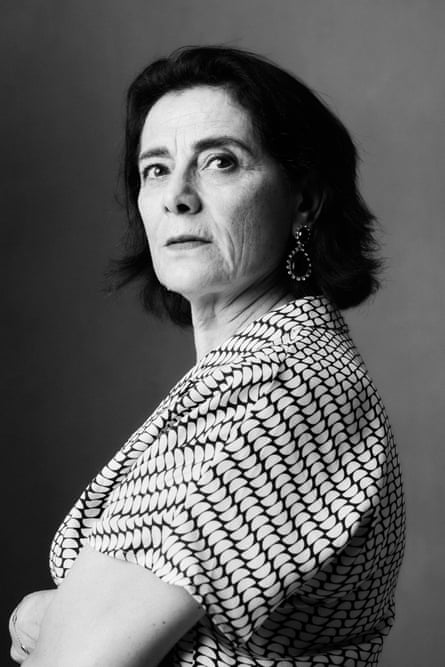Hiam Abbass felt “suffocated” growing up as a Palestinian woman in what had recently become the state of Israel. She was unable to travel to other Arab countries where her own relatives had been forced to live after being expelled during the Nakba of 1948. Feeling at odds with the rest of the world drove her into the arts,
and she enrolled at a photography school in Haifa. Working as a photographer for El-Hakawati theater in Jerusalem was her first step towards acting professionally. “Build a career is not even really the right term,” she says. “What it meant was just to exist, to be what you want to be, without having to give answers at every second of the day to hundreds and hundreds of people.”
Today, Abbass is arguably the world’s most celebrated Palestinian actor. Most recently known for her roles in Succession and Ramy, she has performed for decades in French, English and Arabic across television and cinema.
Now, for the first time, she is appearing as herself, in a documentary directed by her daughter, Lina Soualem. Bye Bye Tiberias reflects on Hiam’s fraught decision to leave the region for Europe as a young woman. She didn’t return home again until after Lina was born in 1990.
At a moment when so much of the world’s attention is trained on the extraordinary violence of Israel’s military assault on Gaza, Bye Bye Tiberias offers audiences another way to engage with the Palestinian experience. A eulogy and love letter both, the film explores the pain and richness of a Palestinian heritage transmitted through the maternal line, following four generations of women of Lina’s family: great-grandmother, Um Ali; grandmother, Nemat; mother, Hiam; and daughter, Lina herself.
There couldn’t be a more urgent moment to be exploring the themes of family, land and exile in Palestine. But rather than seeking to explicate the political context in which they were living, the film addresses the personal relationships between these women and their homeland. “What does it mean to be a body on this land? What does it mean to be dispossessed as an individual, and not just the concept or the general idea of what that means? I wanted to portray the women of the film with their full humanity, and not in comparison with or in confrontation with,” Lina says.
During the Nakba of 1948, Hiam’s grandparents were expelled by Zionist militias from their village, Shajara, near the city of Tiberias. Some relatives ended up in Syria. Her grandmother, Um Ali, and her children settled in the Lower Galilee, in the new state of Israel. After two years of military rule under the nascent regime, they were given Israeli citizenship.
“When you come from this land, this land that was partially lost,” says Hiam, “your relationship to your land is not like that of any other person on Earth for whom there is no danger of such loss.”
The documentary comprises three kinds of footage: Lina’s own of the village of Deir Hanna and elsewhere in Palestine; her father’s footage from the 1990s in the village; and archival footage of both pre- and post-Nakba Palestine.
“Lina was going to do something I wasn’t able to do,” says Hiam. “Maybe because she had this lake of distance from our heritage. This is a hard heritage to tackle. Suddenly there is Lina with this idea, almost as if she had read my mind.”
The greater challenge for Hiam was having to star in the film herself. “Being before the camera in such a frontal way, answering intimate questions about your life, about your past, about your family … you feel like you’re putting everybody in danger, and first of all yourself. I’m an actress, I slip into the bodies of my characters when I’m acting, but never into my own body. This was a different exercise, which I wasn’t comfortable with.”
She says she eventually found a new “language” with her daughter. Lina developed a stronger sense of what she wanted, and Hiam had her own revelation: “I was suddenly gripped by the feeling that it was my duty to be part of Lina’s movie,” a feeling that overrode any discomfort at being directed by her daughter, or at exploring sensitive areas of her family history. “Because it wasn’t really about me. It’s about how I fit into a story of four generations of women. Lina is questioning the history and collective memory of these women, how they influenced each other – and I am part of the chain. I can’t break that chain. I have no right to break it.”
At points in the film, we see Lina directing Hiam to dramatize her memories. This, Lina explains, was a method “to access an emotion that she had lived, but that was hard to formulate in the present”. One such scene takes place inside El-Hakawati theater with another veteran Palestinian actor, Amer Khalil. Together they re-enact Hiam’s memory of announcing to her father the news of her engagement. Mid-scene, Lina offers a direction, and Hiam turns and asks, sharply: “Lina, what do you want, exactly?” For the first time, a tension between their parental and professional relationships breaks the surface. I ask them about this moment, which stayed with me.
“I was being truthful to my feelings,” says Hiam. “If you take the death of my mom, my return to the empty house in Deir Hanna – it was not easy to have a camera on me, reading all of that. At a certain stage Lina managed to make me forget about the camera, and I was just with a director who was doing her thing, almost as if I were in a fiction film. But then, sometimes, I would become aware of the camera again. Suddenly, I see Lina, my daughter, behind it.”
For Lina, it was disturbing: she couldn’t answer the question of what she wanted. She planned to cut this exchange, which made her uneasy when she watched it. But during the editing process she came to see its value. It encapsulated what the film as a whole was trying to do: push open the stiff doors to past pain, and track that endeavour through the complicated relationships between mothers and their daughters. Lina suggests that, in fact, it was probably the provocation of emotion in her mother’s memory that caused her to break the fourth wall in that way.

Three times during the film, Hiam situates us inside the geography, pointing to the borders in the distance: there’s Syria, there’s Lebanon, and over there is Jordan.
“In the Nakba, people lost so much, and part of my heritage is that loss. My mother lived, viscerally, with her mother, the exodus – they literally walked together into exile. And this land that we managed to stay on was suddenly surrounded by real frontiers that wouldn’t allow you to reach the other side,” says Hiam.
Throughout the film, Israeli troops loiter in the background. Soldiers appear in footage of an outing to Jerusalem in the 90s, and a shot of Hiam sitting by the waters of Lake Tiberias. “The viewer’s eye automatically goes to the extreme military presence,” says Lina. “It’s always present, it’s part of daily life.”
One irony is that through her departure, by saying “bye bye” to Tiberias, Hiam eventually obtained a French passport and was able to cross the borders imposed by the Israeli state. In one of the film’s most moving scenes, she describes travelling to Yarmouk, the Palestinian refugee camp in Syria, to meet her aunt Hosnia. (As Israeli passport holders, most of her family are not able to do this.) The two women ran at each other “like two magnets”. Her aunt kissed her repeatedly and smelled her, seeking the scents of home and of her mother, mentioning each member of her lost family by name.
Through chronicling the departures and returns of the women in her lineage, Lina’s film itself enacts a kind of return, generating a new link to the place. “Each image that I was filming was becoming an archive as soon as I captured it,” she says. “Through the film I wanted to create an imaginary territory in which all these different places could coexist, and all these different generations of women could exist in the same timeframe. As if it was a utopia. A way to cross the distance that exile creates.”
I ask how it has been to promote the film during this catastrophic time. With the continuing genocidal attack on Gaza, we have also seen a huge amount of repression of Palestinian and pro-Palestinian voices in mainstream spaces. “It has been difficult and frightening,” says Lina, “especially in the context of the great dehumanization of Palestinians.”
With more than 36,000 Palestinians massacred so far, more than 2 million displaced, many of them multiple times, and no end in sight to Israel’s military campaign, one cannot help feeling we are watching the catastrophe of 1948 repeated on an industrial scale. “Whatever happens in Gaza,” Hiam says, “reminds you of an eventual future that might have happened to these characters in the movie”. Besides, most of the population of Gaza are refugees from elsewhere in Palestine, displaced like their family in 1948, who “could easily have been refugees in Gaza, as well. It was just chance that these women stayed where they stayed.”
Still, says Hiam, “people have received the movie as a piece of love. To talk about Palestinians in that way, and not just in terms of numbers of death or destruction, of people starved. We could feel from the audience almost relief to receive this side of the story. When these reactions kept coming – despite the difficulties, despite the war getting worse and worse, and more and more loss, more and more bloodshed, more and more kids killed, and women killed, and old men killed, and people displaced … that was something that gave us power to continue.”
Bye Bye Tiberias opens at selected cinemas in the UK from 28 June. Lina Soualem and co-writer Nadine Naous will attend a preview at Safar Film Festival from 21 June. It is released in the US by Women Make Movies.
Isabella Hammad is a novelist and essayist. Her new book Recognizing the Stranger: On Palestine and Narrative is out this autumn
Source: theguardian.com




















